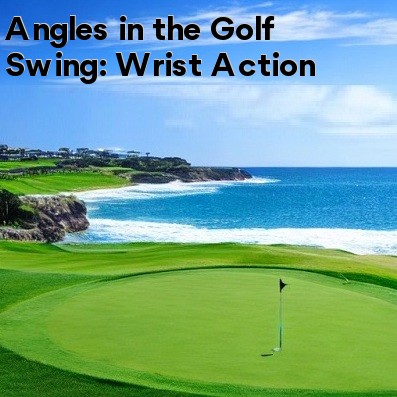
In golf, Angles in the Golf Swing: Wrist Action
The golf swing is a complex motion that involves the entire body. One crucial aspect of the swing is the movement of the wrists. The proper wrist action can lead to better control, increased power, and improved consistency in your shots. Understanding the angles in the golf swing related to wrist action is essential to improve your game.
- Address Position:
Before we dive into the angles during the swing, let's first discuss the address position. At address, your wrists should be relatively neutral with minimal bend. Your lead wrist (left wrist for right-handed players) should be relatively flat, while your trail wrist (right wrist for right-handed players) will naturally have a slight cupping.
- Backswing Angle:
During the backswing, the lead wrist starts to hinge, creating an angle. This angle allows for the proper loading of power in the swing. Ideally, the angle in the lead wrist should reach approximately 90 degrees at the top of the backswing. This angle ensures that the clubface remains square, leading to better accuracy and consistency.
As you transition from the backswing to the downswing, the wrists play a vital role in generating power. The lead wrist should start to bow, meaning it flexes toward the target. This bowing action allows for a powerful release of the clubhead through impact. At this point, the angle in the lead wrist reduces from 90 degrees in the backswing to about 30-45 degrees.
- Impact Angle:
At impact, the angle in the lead wrist should be neutral or slightly bowed. This position ensures a square clubface at impact, maximizing accuracy and distance. If the wrist is overly cupped or arched at impact, it can result in an open or closed clubface, leading to slices or hooks.
- Release Angle:
After impact, the wrists continue to play a role in the release of the clubhead. The lead wrist gradually rehinges and returns to a slightly cupped position in the follow-through. This rehinging action helps maintain control and provides a smoother, more consistent release of the club.
- Common Mistakes:
Many golfers struggle with their wrist angles, leading to inconsistencies in their swing. One common mistake is not hinging the lead wrist enough during the backswing, resulting in a lack of power and control. Another mistake is cupping or arching the lead wrist excessively at impact, causing the clubface to be open or closed. Practice exercises and drills focused on improving wrist angles can help correct these errors.
Taking the time to understand and practice the proper wrist angles in the golf swing can significantly improve your game. Working with a golf instructor or studying videos of professional golfers can provide additional guidance and visual examples. Remember, the wrists play a crucial role in generating power, accuracy, and consistency in your shots, so give them the attention they deserve!
The wrist action in the golf swing is a complex and important topic. There are many different opinions on how to best use the wrists in the swing, and what the ideal wrist positions are at different points in the swing.
Here are some general tips on how to control wrist action in the golf swing:
- Keep your wrists firm at address. This will help you to maintain a consistent swing path and clubface angle.
- Allow your wrists to hinge naturally as you take the backswing. This will help you to generate clubhead speed and power.
- Do not over-waggle or break your wrists too much at the top of the backswing. This can lead to a loss of control and accuracy.
- In the downswing, allow your wrists to release naturally. This will help you to square the clubface at impact and hit the ball solid.
- Do not try to force the clubface closed with your wrists. This can lead to a loss of power and accuracy.
It is important to experiment with different wrist positions and find what feels comfortable and works best for you. There is no one-size-fits-all approach to wrist action in the golf swing.
Here are some common mistakes to avoid when it comes to wrist action in the golf swing:
- Over-wiggling or breaking your wrists too much at the top of the backswing. This can lead to a loss of control and accuracy.
- Trying to force the clubface closed with your wrists. This can lead to a loss of power and accuracy.
- Not allowing your wrists to release naturally in the downswing. This can lead to a loss of power and accuracy.
- Using too much wrist action in the swing. This can lead to a loss of control and accuracy.
By following these tips, you can learn to control your wrist action in the golf swing and hit the ball more consistently.
Q1: How does wrist action affect the golf swing? A: Wrist action plays a critical role in controlling the clubface and generating power. The right wrist action can help maintain proper angles and ensure a square impact.
Q2: What is wrist cock? A: Wrist cock is the angle formed between the lead forearm and the clubshaft during the backswing. It stores energy that is released during the downswing.
Q3: How does wrist cock impact clubhead speed? A: Wrist cock stores potential energy that is released as kinetic energy during the downswing. This contributes to increased clubhead speed and distance.
Q4: How can I achieve the right wrist cock? A: Focus on allowing the wrists to hinge naturally during the backswing. Avoid forcing or manipulating the wrists excessively.
Q5: Should I maintain wrist cock throughout the entire swing? A: Wrist cock should be maintained during the backswing and then released gradually during the downswing. It's not maintained through impact.
Q6: What is wrist release? A: Wrist release is the gradual unhinging of the wrists during the downswing. It allows the clubhead to square up at impact.
Q7: How does wrist release affect shot accuracy? A: Wrist release is crucial for squaring the clubface at impact, leading to more accurate shots. A proper release prevents slices and hooks.
Q8: Can improper wrist action lead to mishits? A: Yes, improper wrist action can lead to inconsistent shots, slices, hooks, or thin shots. It's important to practice proper wrist mechanics.
Q9: How can I practice improving wrist action? A: Use mirror drills to monitor wrist hinge and release. Focus on feeling the natural flow of your wrists during practice swings.
Q10: Are there drills to help maintain wrist angles? A: Yes, one drill involves holding a towel under your lead arm while swinging. This promotes proper wrist hinge and extension through impact.
Q11: Can wrist action be different for different shots? A: Yes, you might adjust your wrist action for various shots. For example, a flop shot might involve more wrist hinge for a higher trajectory.
Q12: What is the key to consistent wrist action? A: Relaxation and maintaining a light grip pressure are key. Tension in the hands and wrists can hinder proper wrist movement.
Q13: How does wrist action relate to club fitting? A: Understanding your wrist action helps in club fitting. Clubs with the right shaft flex and weight can better suit your wrist mechanics.
Q14: How do I prevent casting or early release? A: Practice drills that encourage a gradual release, like the “pump drill,” where you rehearse the downswing while maintaining wrist hinge.
Q15: Any final tips for mastering wrist action? A: Be patient; mastering wrist action takes time. Focus on maintaining a smooth tempo and rhythm to ensure proper wrist mechanics.






